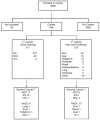Trends in the incidence of cancers among HIV-infected persons and the impact of antiretroviral therapy: a 20-year cohort study
- PMID: 19050385
- PMCID: PMC2727153
- DOI: 10.1097/QAD.0b013e328317cc2d
Trends in the incidence of cancers among HIV-infected persons and the impact of antiretroviral therapy: a 20-year cohort study
Abstract
Objective: To describe trends in incidence rates of AIDS-defining cancers (ADCs) and non-AIDS-defining cancers (NADCs) during the HIV epidemic and to evaluate predictors, including the impact of antiretroviral therapy, of cancer development.
Design: Retrospective analysis of a multicenter, prospective natural history study including 4498 HIV-infected US military beneficiaries with 33 486 person-years of follow-up.
Methods: Predictors evaluated included demographics, clinical data, time-updated CD4 cell counts, HIV viral loads, and antiretroviral history. Time periods were classified as early pre (1984-1990), late pre (1991-1995), early post (1996-2000), and late post (2001-2006) HAART eras. Cox proportional hazard models were used to evaluate the association of specific factors with cancer.
Results: Ten percent of HIV-infected persons developed cancer. ADC rates increased between the early and late pre-HAART eras (7.6 and 14.2 cases per 1000 person-years) and have since declined from 5.4 to 2.7 in the early and late HAART eras, respectively (P < 0.001). Rates of NADCs have risen over the four periods (2.9, 2.8, 4.2, 6.7, P = 0.0004). During the late HAART era, 71% of cancers were NADCs. Predictors for ADCs included low CD4 cell count, noncancer AIDS diagnosis, and lack of HAART. NADCs were predicted by increasing age and white race (due to skin cancers).
Conclusion: Although the rate of ADCs continues to fall, the rate of NADCs is rising and now accounts for the majority of cancers in HIV-infected persons. The development of NADCs is associated with increasing age among HIV patients. HAART use is protective for ADCs, but did not significantly impact NADCs.
Conflict of interest statement
The opinions or ascertains contained herein are the private views of the authors and are not to be construed as official or as reflecting the views of the Departments of the Army, Navy, or Air Force, or the Department of Defense. The authors have no commercial or other association that might pose a conflict of interest in this work.
Figures


Comment in
-
A role for ageing and HIV infection in HIV-related cancer risk.AIDS. 2009 Jun 1;23(9):1183-4. doi: 10.1097/QAD.0b013e32832cb284. AIDS. 2009. PMID: 19451797 No abstract available.
-
Trends in the incidence of cancers among HIV-infected persons and the impact of antiretroviral therapy: authors' reply.AIDS. 2009 Aug 24;23(13):1791-2. doi: 10.1097/QAD.0b013e32832cb296. AIDS. 2009. PMID: 19684484 No abstract available.
References
-
- Centers for Disease Control (CDC) Kaposi’s sarcoma and Pneumocystis pneumonia among homosexual men – New York City and California. MMWR Morb Mortal Wkly Rep. 1981;30:305–308. - PubMed
-
- Monfardini S, Vaccher E, Pizzocaro G, et al. Unusual malignant tumours in 49 patients with HIV infection. AIDS. 1989;3:449–452. - PubMed
-
- Centers for Disease Control (CDC) Update on acquired immune deficiency syndrome (AIDS) – United States. MMWR Morb Mortal Wkly Rep. 1982;31:507–14. - PubMed
-
- Centers for Disease Control (CDC) 1993 revised classification system for HIV infection and expanded surveillance case definition for AIDS among adolescents and adults. MMWR Morb Mortal Wkly Rep. 1992;41:961–962. - PubMed
-
- Grulich AE, Li Y, McDonald A, et al. Decreasing rates of Kaposi’s sarcoma and non-Hodgkin’s lymphoma in the era of potent combination antiretroviral therapy. AIDS. 2001;15:629–633. - PubMed
Publication types
MeSH terms
Substances
Grants and funding
LinkOut - more resources
Full Text Sources
Other Literature Sources
Medical
Research Materials

